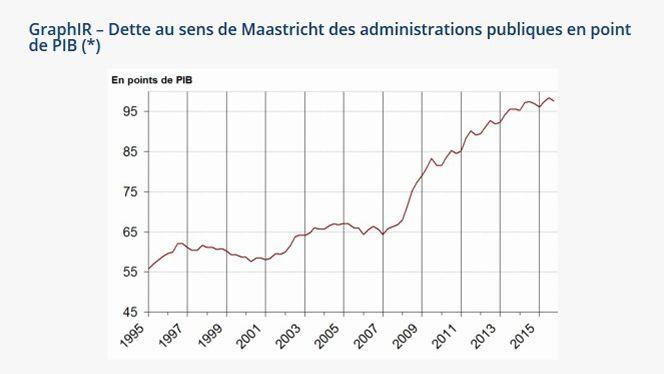The debt of France has slightly decreased to reach the equivalent of 97.6% of GDP, according to data published this Friday by the Insee.
2160,4 billion euros. This is the amount of the public debt of France in the third quarter, according to data published this Friday by the national Institute of statistics and economic studies (Insee). This amount is down from $ 10.3 billion compared to the previous quarter. Reported to the national wealth, the debt of all public administrations, measured according to the Maastricht criteria, reached 97.6% of GDP, compared to 98.4% at the end of the second quarter of the year.
the ratio of debt in the third quarter, however, remains above the target displayed by the French government for the whole of 2016. According to Bercy, the public debt is expected to reach 96.1% of the GDP this year, as last year, and stabilize next year at 96%.

Insee
The State’s contribution to the debt dropped by € 2.3 billion over the period to 1722,6 billion, a decrease which “comes essentially from that of the marketable debt in the short term (-10,2 billion euros),” says Insee. But it has been “partially offset by an increase of the outstanding amount of long-term securities” (+eur 7 billion).
The contribution to the debt of social Security funds (Asso) also decreased, from 4.8 billion euros to 228,5 billion, “mainly due to the Acoss (collector organization of social Security contributions, editor’s NOTE), which will reimburse € 6.8 billion of debt securities to units outside of the public administrations,” notes the Insee. The contribution to the debt of local public authorities (Lufa) is decreasing also, $ 1.7-billion eurosà 192,9 billion. “The departments and the regions désendettent (-0,8 billion euro in both cases), as well as the municipalities (-0,4 billion euro) and the intermunicipal unions (-0,1 billion euro). Finally, the debt of the central government agencies (Odac) declined by € 1.5 billion to $ 16.5 billion.
On the other hand, the net public debt, which takes into account the cash in the coffers of the public administrations, has increased – albeit moderately – to 3.6 billion euros, 1952,5 billion, or 88.2% of GDP (compared to 88,4% in the previous quarter).
The French are buying fewer televisions and more cars
Insee also announces this Friday that the consumption expenditure of French households in goods increased again in November, gaining 0.4% after having already risen 0.8% in October. In detail, the energy consumption increased by 1.4%, due in particular to temperatures below normal. This increase, according to the Insee, however, is less vigorous than in October (+3.6 per cent).
The purchases of goods manufactured to their share increased moderately (+0.3%), and supported by spending on durable goods, which rose for the fourth consecutive month (+0.9 percent). “In particular, purchases of new automobiles and motorcycles bounce around significantly”, emphasizes the statistical institute, which is in contrast state of a downturn, purchases of equipment of the dwelling (-0,9%), related in particular to a fall in purchases of tvs, after a first half very dynamic.
spending on clothing and textile is are they collapsed (-0,9%), while the consumption of food products remained stable, the decline in the level of fresh products which were offset by an increase in purchases of agri-food products.
The figures of consumption are an important factor in French growth, traditionally driven by the purchases of households. According to Insee, the latter has indeed capped at 0.2% in France in the third quarter, according to a third and final estimate. A figure following the coup is a sudden stop experienced by the French economy in the second quarter (0.1 per cent), reminds us of the Insee.
No comments:
Post a Comment